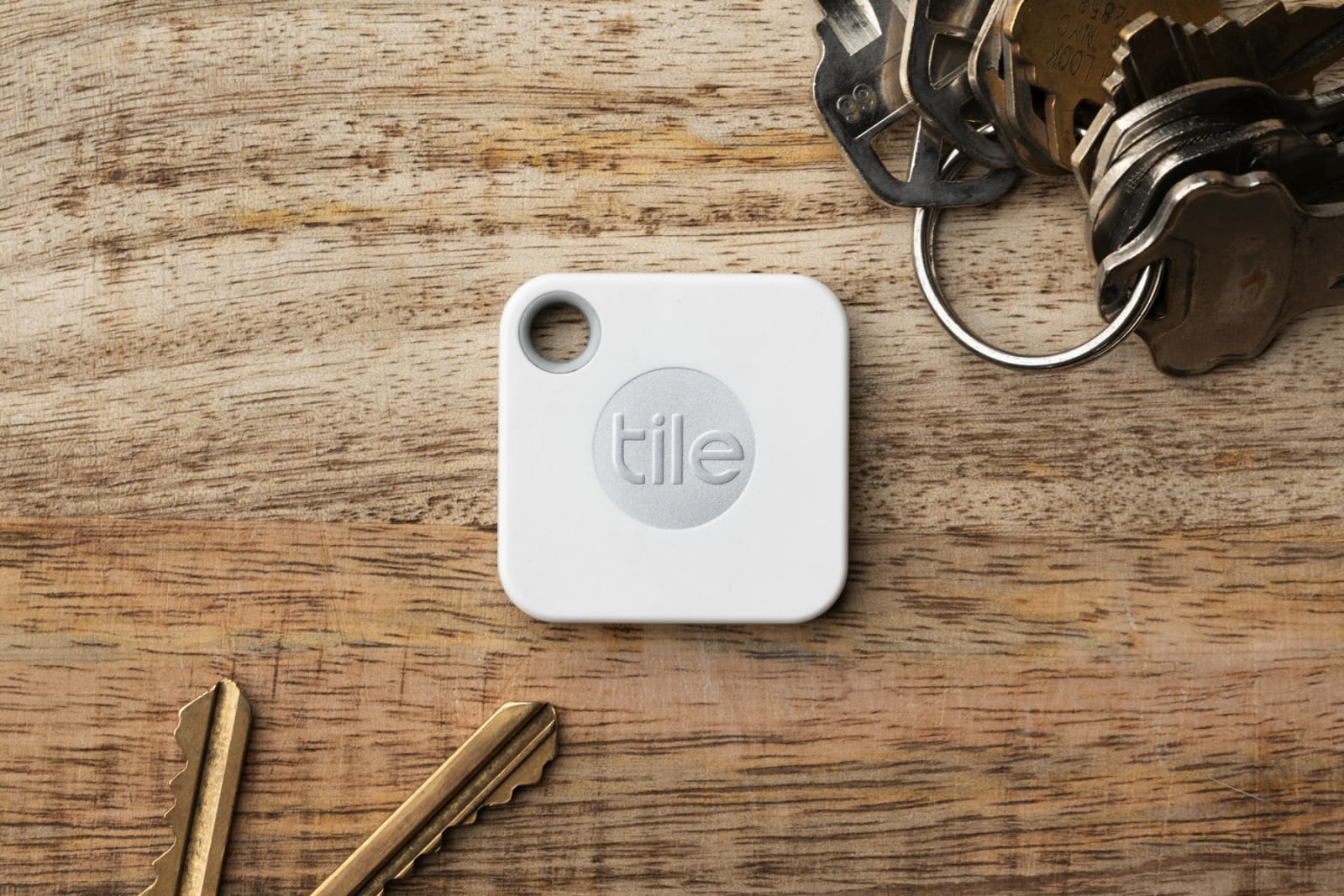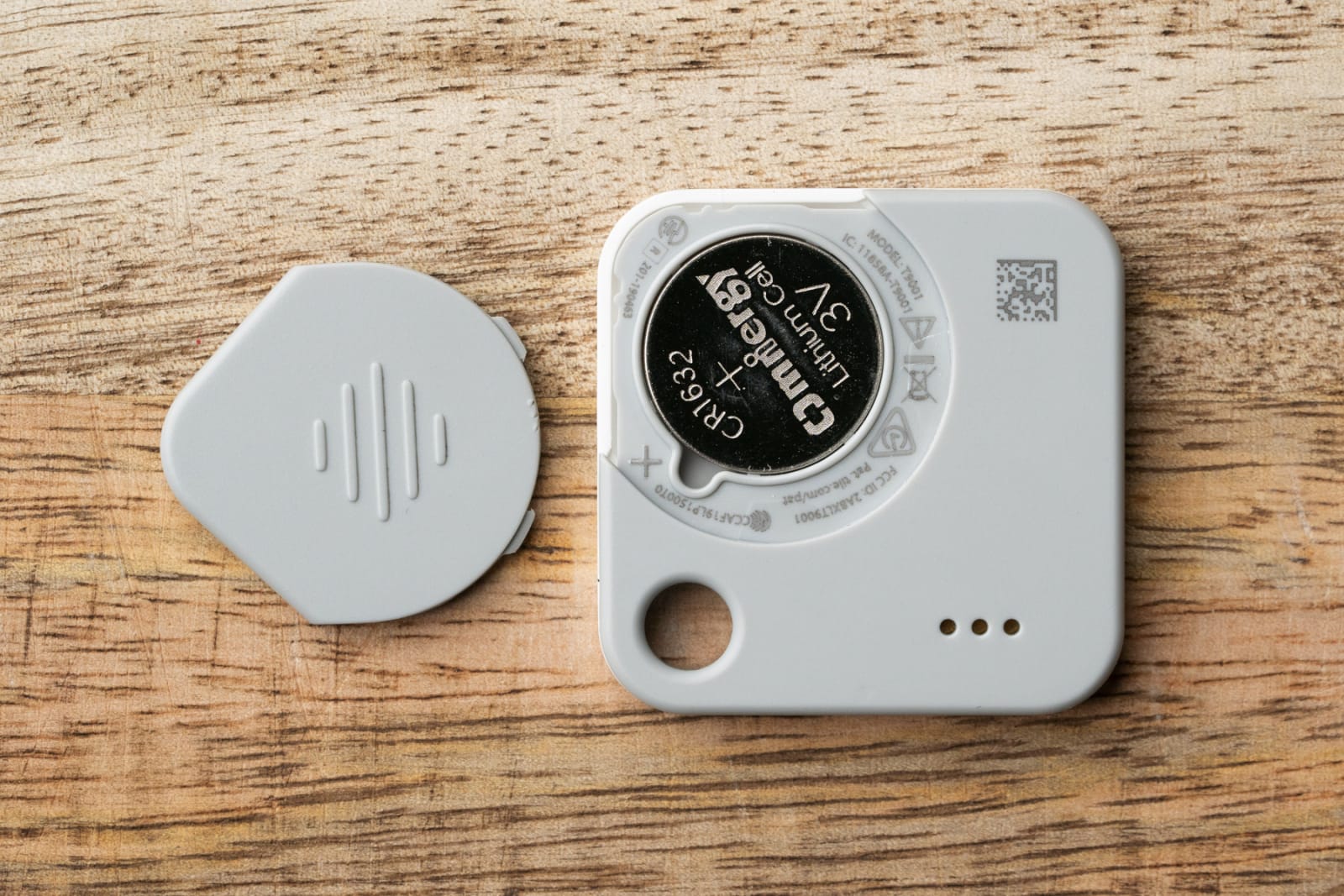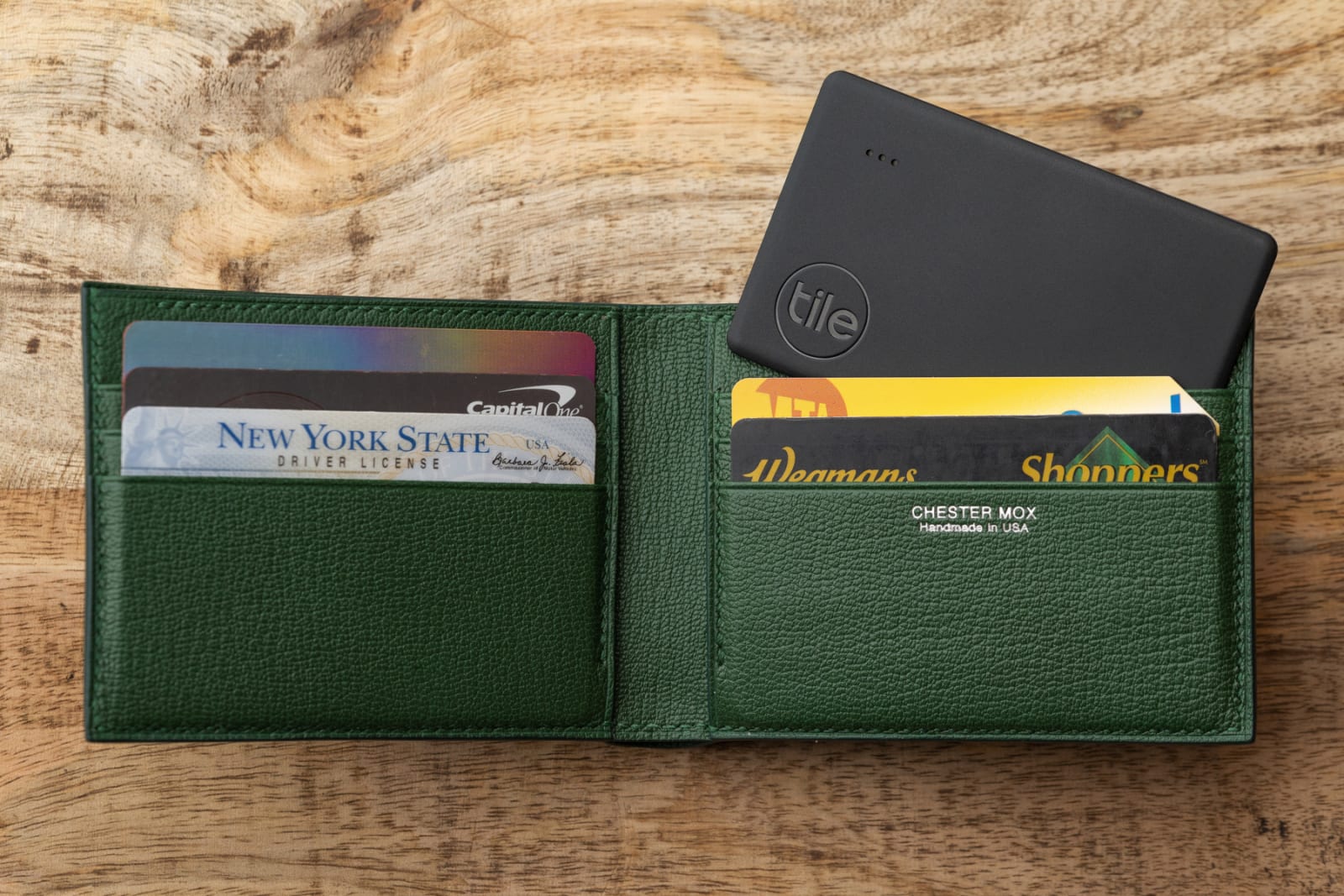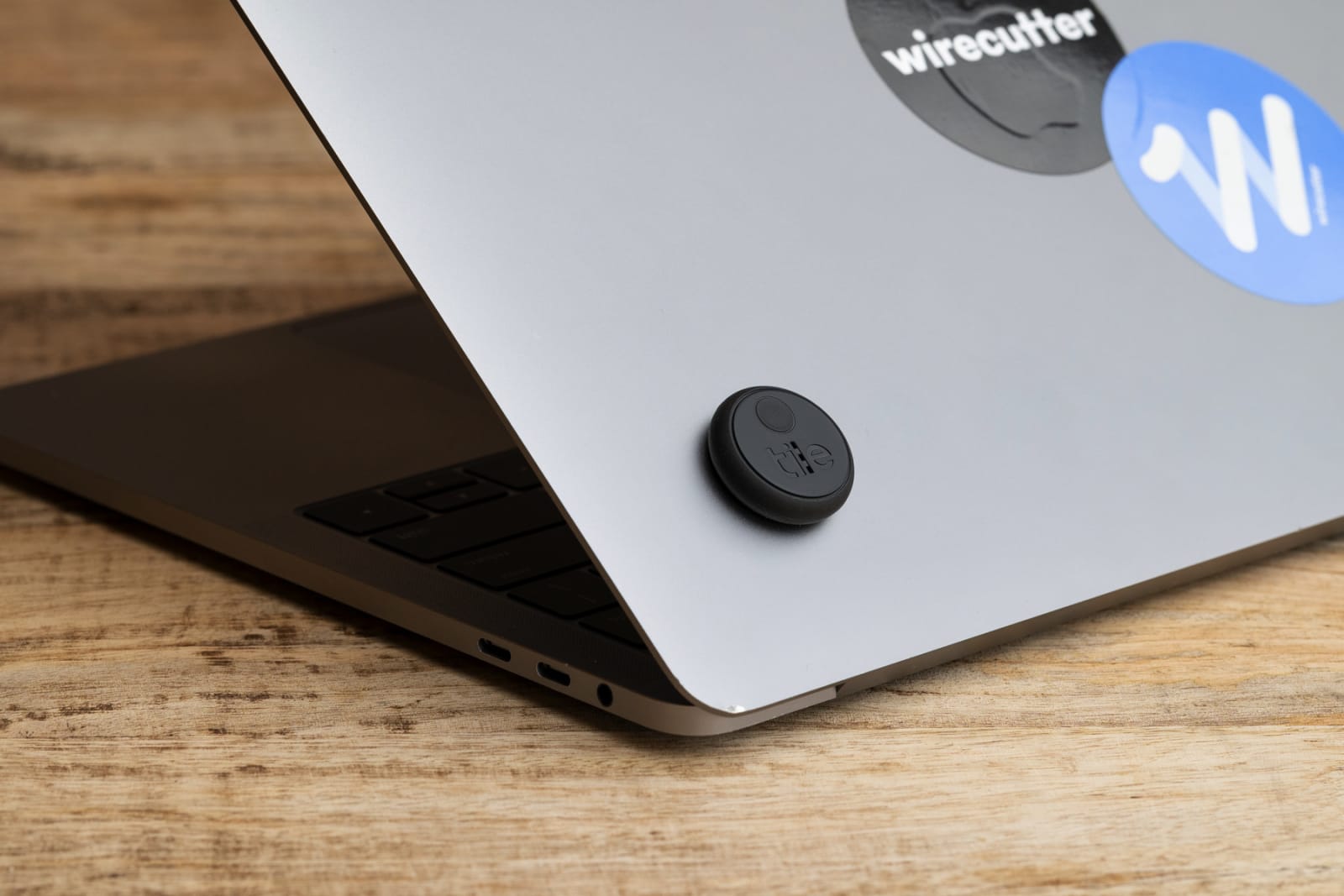
By Nick Guy
This post was done in partnership with Wirecutter. When readers choose to buy Wirecutter’s independently chosen editorial picks, Wirecutter and Engadget may earn affiliate commission. Read the full guide to bluetooth trackers.
If you find that you’re often scrambling to locate your keys or bag as you’re heading out the door, a Bluetooth tracker can be a lifesaver. Tile Mate (2020) is the one you should attach to your gear. It has a range that’s long enough to cover most homes or workplaces, a loud alarm, and a replaceable battery. And it costs a little less than the top-of-the-line Tile Pro (2020).
Bluetooth trackers let you use a smartphone app to monitor the location of whatever they’re attached to, and Tile as a company has become synonymous with trackers in the way Kleenex is with facial tissue. In our testing, the Tile Mate’s 150-foot range didn’t quite measure up to the 190-plus-foot range of the Tile Pro, but it’s long enough that most people won’t go out of range in their house or at the office. You can also remotely trigger a sound on the tracker to locate it when you’re nearby (say, when you’ve misplaced your keys in your house), and the Tile Mate is just as loud as more expensive models. When the tracker is out of Bluetooth range, a crowd-finding feature allows others with the Tile app to help you locate your item, and Tile has the largest network of its kind.
Tile Slim (2020) and Tile Sticker (2020) have shorter ranges and quieter alarms than the Tile Mate, and they don’t have user-replaceable batteries. But they are designed to be used in different places, and they offer all of the benefits of the Tile ecosystem. The former is modeled on a credit card and designed for your wallet; the latter is tiny and can adhere to pretty much anything. The Tile Essentials (2020) bundle includes a Tile Mate, a Tile Slim, and two Tile Stickers at a discount, so it’s a good starter combination.
How we picked and tested
Over the past few years, we’ve tested more than a dozen Bluetooth trackers. The major players in this category are well known. But to make sure we didn’t miss any, we turned to Amazon and Google during our research for a previous version of this guide. The latter turned up some great comparative reviews from The Wall Street Journal, Yahoo, Tom’s Guide, and Wired.
Here’s what we look for in a great Bluetooth tracker:
- Size: A tracker that’s too obtrusive to carry around with you or to attach to the thing you want to track is useless. Smaller and lighter is better.
- Range: The longer the range, the farther you can be from the tracker and still be able to find your lost item.
- Volume: If you’re near your tracker but you can’t hear it, that’s no good. Despite having little space for a speaker, some of these can get quite loud!
- Network size: Most Bluetooth trackers can utilize other phones that have the tracker’s app installed to silently search for your lost objects—so the more people who use a platform, the better your chances of recovering lost stuff.
- Other features: A replaceable battery isn’t absolutely required, but it’s a big plus. We also prefer trackers that can be used to trigger an alarm on your phone. An app that is easy to navigate and that updates location information quickly is also important.
The most important test we conducted was to determine each tracker’s potential range—how far away we could move a paired smartphone from the tracker before the Bluetooth connection was lost. In 2019, we tested the range in Wirecutter’s 190-foot-long New York City office. We set each tracker on a shelf, triggered it to ring, and then walked away with our paired iPhone while measuring the distance using a measuring wheel. Once the tracker’s smartphone app showed the tracker as out of range or we physically hit the wall, we recorded the distance. We repeated this test at least five times per tracker and calculated the average distance for each tracker for both measurements.
We also tested the loudness of each tracker’s alarm chime—a feature that’s useful for finding a lost device that’s still within earshot—by placing it directly next to a digital sound pressure level (SPL) meter and noting the peak volume.
Our pick: Tile Mate (2020)
If you’re going to buy a tracker to keep tabs on your keys, bag, or other gear, it should be the Tile Mate (2020). Tile trackers are the most popular by far, which is important if you ever need to take advantage of the crowd-finding feature (more on that in a bit). And this model offers the right combination of range, alarm volume, and price. It also has a user-replaceable battery, addressing the single biggest drawback of older Tile devices, and it’s small enough to fit on a keychain.
The Tile Mate is a round-cornered square that’s about 1.38 inches across and 0.24 inches thick—smaller than a matchbook. It’s made of white plastic and has a flat button in the center. An opening in the top left corner lets you attach a keychain, lanyard, or similar tether. This Tile Mate is identical to the 2019 model, at least on the outside.
In our distance test, the Tile Mate didn’t have the best range we’d ever seen from a Bluetooth tracker, but it was impressive enough that we don’t think most people need to spend the extra money on the Tile Pro. We were able to get an average of about 152 feet away before losing the connection with our iPhone. That’s less than the 200 feet that Tile advertises, but it’s still an impressive number—and 50 feet more than the previous version of the Tile Mate offered. Although the Tile Pro outperformed this figure, 150 feet is longer than you might think it is—about one and a half times the length of a basketball court—and it’s plenty of allowance for most homes or offices. If you regularly leave your stuff in more-remote spaces, or you just want the extra peace of mind, the Tile Pro will serve you well: The Tile Pro made it to the end of our 190-foot-long office without losing its connection.
Tile advertises the Tile Pro as being louder than the Tile Mate, but side by side, they sounded about the same and measured the same on our sound meter. We measured both at just over 104 dB, which is far louder than the previous versions of both—or any other tracker we’ve tested—and it’s certainly loud enough to hear on the opposite side of an office or apartment.
If the Tile is out of Bluetooth range, you can view a map displaying its location the last time your phone made contact with it. If your phone is no longer at that location—or you’re worried that it won’t be—you can mark the item as lost, which will invoke Tile’s crowd-finding feature. Other trackers have similar crowd-finding features, but the Tile’s big strength here is the size of its crowd. Tile tells us it has sold more than 26 million trackers, a claimed 90 percent of the Bluetooth tracker market. According to the company’s figures, 6 million items are found daily, and of those marked as lost, Tile says 90 percent are found. (As a point of reference, the Tile app tells you how many other active Tile users are within roughly 5 to 6 miles of your current location.)
With older Tile models, each tracker lasted only about a year before its internal battery was drained and the entire tracker had to be replaced. The current Tile Mate and the Tile Pro both use replaceable batteries (in the Tile Mate, it’s a standard CR1632 lithium battery) that are easily accessible via a slide-off door on the back. Tile says the battery will last a year before it needs to be replaced; you can easily find these batteries for less than $1 apiece. (If you upgrade an older Tile through the reTile program, you’ll receive one of the new ones.)
Because the battery door could possibly be reinstalled incorrectly, Tile can’t call the Tile Mate waterproof. But the company has told us it still considers this tracker to be water-resistant, which means that dropping it in a puddle or having it out in the rain shouldn’t kill it. According to Tile, test units survived 1,000 cycles in a dryer, so you should expect the hardware to last longer than the battery.
Tile offers Tile Premium, an optional, $3-per-month (or $30-per-year) subscription service that covers as many Tiles as you own. The services include free battery replacements shipped to you each year, a warranty extension from one year to three, and SMS-based support. On the software side, there’s a 30-day location history, unlimited sharing of your Tiles’s locations, and smart alerts that let you know when you’ve left home without any of your Tiles. The last feature is based on entering your home address, and in our testing, we could get a third of a mile away before getting the alert, which isn’t super-handy. We think Tile Premium is an unnecessary expense for most people.
Setting up any Tile is simple: Instead of having to go into your phone’s Settings menu to add the Tile, the Tile app (Android, iOS) handles everything. You just launch the app, tap a button to add a new Tile, and press firmly on the Tile’s center button when prompted.
In the app, you can name each Tile whatever you like and also add a photo. For example, if you have a Tile Mate in your backpack, you can add a photo of the backpack for that particular Tile. You can view your devices—all Tiles, your paired phone, and any other phones and tablets running the Tile app under your account—in list or map modes. You can pair an unlimited number of Tiles with a phone, but only eight (on iOS) or four Tiles (on Android) can be actively communicating (via Bluetooth) with the phone at once.
Flaws but not dealbreakers
The Tile Mate lacks geofencing features (to let you know when you’ve left a tracked item behind), unless you pay for Tile Premium. Even then, we’ve found its performance to vary widely: One Wirecutter staffer who uses this feature regularly receives notifications within a few blocks of leaving home, but another doesn’t get notices until he’s nearly 10 minutes away.
Also great: Tile Slim (2020) and Tile Sticker (2020)
If you’ve bought into the Tile ecosystem, you may want to tag more of your stuff than just your keys. The Tile Slim (2020) and Tile Sticker (2020) use the same technology as the Tile Mate, but in different styles that can be useful in a variety of situations.
Tile Slim is Tile’s hardware designed for your wallet. It’s in the shape of a credit card, and, at 2.4 millimeters, it’s as thick as three of them. Despite its thin size, the Tile Slim has the expected button for ringing your phone and a speaker. It’s the quietest Tile of the 2020 lineup, but at 99.5 dB in our testing, it’s still surprisingly loud (about as loud as a lawn mower or a motorcycle engine). The speaker is cleverly located toward the top of the card when it’s held either vertically or horizontally, allowing it to stick out above a card pocket so that the sound isn’t blocked. We measured the Tile Slim’s range at 144.4 feet, compared to the promised 150 feet, so it’s pretty much spot-on.
Tile Sticker is a brand new design, and it’s the smallest Tile yet. Sold in packs of two or four, Tile Sticker is roughly the size of four quarters stacked, and the small round tracker sticks with adhesive to whatever you want to track. This makes the Sticker a good option for anything that doesn’t have a keyring or tether, and because this tracker is so small, it can be attached discreetly. At 103.9 dB, the Tile Sticker’s speaker is almost as loud as the Tile Mate’s, and it’s cleverly hidden in the Tile logo’s “l.” We measured a shorter-than-advertised 120.2-foot range, but that’s within striking distance of the 150 feet that Tile claims and still pretty impressive for something so small.
image 7
Unfortunately, neither the Tile Slim nor the Tile Sticker uses a replaceable battery, though Tile says the battery will last for three years. The upside is that since they’re sealed, both the Slim and Sticker models are rated IPX7, meaning they can withstand being submerged in water up to a meter deep. When they run out of juice, you can order replacements at a lower cost through the reTile program. Each Tile you own can be replaced at a 30 percent to 40 percent discount, though you’re responsible for recycling the old one yourself—and you can take advantage of the discount only once a year, no matter how many Tiles you want to replace.
How Tile trackers work
Regardless of which Tile you’re using, once a Tile is paired with your phone, you can use the accessory in a few different ways. If you lose track of a Tile-equipped item that’s still in Bluetooth range, you can see its current location on a map in the app and optionally trigger the Tile’s alarm to help you locate the item by sound.
When you designate a Tile as lost in the app, this activates Tile’s Community Find feature to help you find it. This feature takes advantage of any device that has the Tile app installed: If one of those phones or tablets passes within Bluetooth range of your lost tracker, you’ll get an alert on your phone and an email with the location where it was detected. This all happens in the background, invisibly—the person running the app will have no idea where your stuff is, or even that they’ve helped you locate a specific item. This feature worked as advertised in our testing; over the several years we’ve been testing Tile trackers, I’ve received a handful of notifications that I’ve helped someone locate something.
You can also use a Tile to find your phone—if it’s within Bluetooth range. Double-pressing the Tile’s button triggers a tune to play on your phone at full volume, even if the volume is otherwise turned down or the phone is set to vibrate. And if your phone or tablet is not nearby, you can use Tile’s Web service to find linked phones or tablets in any Web browser. The service is very similar to Apple’s Find My tool: It displays your devices on a map, and if one is lost, you can ring it or display a message on its lock screen. We consider this a nice extra, but it’s a shame you can’t also use the website to locate the actual Tile trackers, as you can in the app. You can also use Amazon Alexa or Google Home to find your Tile-connected devices or call for them using Siri Shortcuts on iOS 12 or later.
The Tiles are the only Bluetooth trackers we encountered with an Apple Watch app that shows connected trackers on a map and lets you trigger alarms. This isn’t a huge advantage, but it’s a nice bonus. And Tile is also building out its platform, incorporating its tracking technology into third-party devices. Examples include the KeySmart Pro, a key holder, and Bose SoundSport headphones. Because the Tile platform doesn’t require special hardware, just firmware on a standard Bluetooth chip, the company hopes to greatly expand its partnerships.
The Tile app does need to be running on your phone for it to connect to the trackers, but we’ve found that it stays active in the background, even when you haven’t opened it in quite some time. The app will stop running only if you actively quit it, and even then, the app will send a notification that it needs to be running to track your stuff.
If you’re concerned about the privacy implications of using a Bluetooth tracker, Tile has told us that the company uses your phone’s location data in four ways: determining where you are in relation to your stuff, periodically determining the location of each tracker, noting your location if you’re in range of someone else’s lost tracker, and (if you contact Tile’s support staff) determining the approximate location of your computer or device by IP address. We don’t think any of these uses is particularly invasive for a device that you’re purchasing to locate you and your stuff.
The competition
Tile Pro (2020) is a more expensive and slightly larger version of the tracker, with a longer range. Tile says this model will stay connected for up to 400 feet, or 40 feet longer than the length of a football field. In our tests, the Tile Pro remained connected for the entire, 190-foot length of our office and remained connected. Though a longer range is better, we think that in almost any scenario around the home or office, the Tile Mate will be sufficient. And if your house is longer than 400 feet, you can swing the extra $10 for the Tile Pro.
You may still be able to find the 2018 versions of the Tile Mate and Tile Pro at discounted rates. They have shorter ranges than the 2020 models, but if finding range isn’t your primary concern, these versions work just as well. We would recommend sticking to the current Tile Slim as opposed to the 2016 edition, though, because the newer one fits better in a wallet and has a longer-lasting battery.
Orbit offers a number of tracker styles, including the Orbit Glasses tracker, which fits on eyeglasses or sunglasses, and the Orbit Card, a card-style tracker that’s even thinner than the Tile Slim. These models are intriguing if you need tracking for those specific designs, but unfortunately, the network is just too limited for us to recommend choosing Orbit over Tile. Anecdotally, I lost a pair of sunglasses that were outfitted with Orbit Glasses in busy and tech-heavy New York City. And despite marking them as lost in the app in hopes of an Orbit user passing by and finding them, I never received a notice that the sunglasses were found by another Orbit user. Additionally, I wasn’t notified when the Orbit Card was running low on battery, which could potentially lead to a lost wallet with no way to find it.
TrackR’s Pixel is noticeably smaller than the Tile Mate. Measuring just about an inch in diameter, it’s about the size of a modern dollar coin, and it’s as thick as a stack of three quarters. In head-to-head tests in June 2017, the TrackR Pixel averaged distances of 45.1 feet before disconnecting, shorter than the numbers for any of the Tile models. The TrackR’s shorter range, combined with the Tile’s larger network, keeps us from recommending the TrackR Pixel.
The Chipolo Plus is an impressively good clone of the 2015 Tile (which is no longer available). It’s shaped like a circle rather than a rounded rectangle, but it’s exactly the same thickness, height, and width as that Tile. Like the older Mate, the Chipolo Plus has a non-removable battery, a mail-in upgrade program, and an app that looks a heck of a lot like Tile’s. The Chipolo Plus worked well in our tests, but its ranges and alarm volume were comparable with those of the second-generation Tile Mate, which was quieter than current models. Chipolo also has fewer users than Tile, making its crowd-finding system less robust. Unlike Tile, though, Chipolo’s Web service allows you to see the location of each tracker, and your phone or tablet, from any Web browser.
The Pebblebee Honey has some great attributes, at least at first glance. Its battery is replaceable, and this model has a crowd-finding feature. Unfortunately, when you press the tracker’s button to trigger an alert on a missing phone, it sends a silent text alert, rather than playing an audible tone. A message popping up on the screen doesn’t do much good when you’re looking for the phone itself.
Cube offers three designs of its tracker, Cube, Cube Pro, and Cube Shadow, in a slim, wallet-able size. Though the Cube Shadow promises the same range as the Tile Slim, the Cube and Cube Pro offer half the range as the Tile Mate and Tile Pro, respectively, and the whole family has a smaller crowd-finding network than Tile.
Samsung’s SmartThings Tracker is different from the rest in that it uses a cellular LTE connection and GPS to report its location, rather than just relying on Bluetooth. That means it has a longer range than any Bluetooth tracker because there doesn’t have to be a direct connection, but it has a far shorter battery life and a much higher price. We’ll be testing this model and a few others for an upcoming guide to LTE-based trackers.
This guide may have been updated by Wirecutter. To see the current recommendation, please go here.
When readers choose to buy Wirecutter’s independently chosen editorial picks, Wirecutter and Engadget may earn affiliate commissions.
Author: Wirecutter
Source: Engadget








